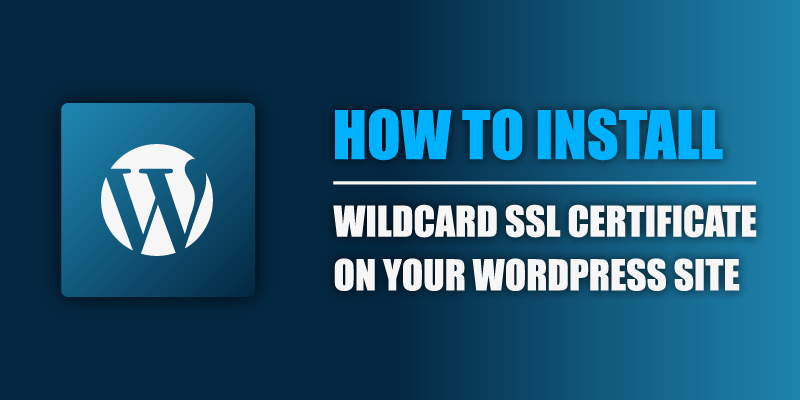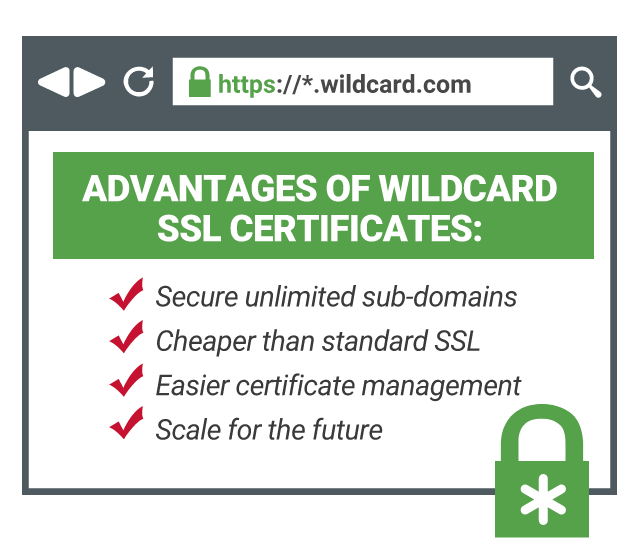Wildcard SSL Certificates – All You Must Know and How to Install Them
The abrupt increase in the number of successful data breaches has led to businesses incorporating robust cybersecurity measures to protect their website and networks. According to Forbes, the cybersecurity market has been pegged at US$ 173 billion globally. It is expected to grow to US$ 281.74 billion by 2027. The websites of industry stalwarts may have several subdomains that you can protect with a Wildcard SSL certificate.
Moving to an HTTPS site can help by enhancing the integrity of the website. It helps by encrypting the communication between the web server and the browser of the visitor. No unauthorized third-party can have any access to this communication. Web browsers are marking Non-HTTPS websites as “Not Secure”, making several visitors move away from the website. This makes it necessary for websites with several sub-domains to install a Wildcard SSL certificate.

Contents
Understanding Wildcard SSL Certificates
As a webmaster, if you are trying to secure multiple sub-domains, the Wildcard SSL certificate is ideal for you. It can work for any of the subdomains of the base domain for which you have installed the certificate. For example, if you have installed the certificate for mywebsite.com, the certificate will be valid for these sub-domains, viz. blog. mywebsite.com, sub.mywebsite.com, sub1.mywebsite.com, etc. There are several options from which you can choose a cheap SSL certificate like Wildcard.

It must be pointed out that Wildcard certificates are different from multi-domain SSL certificates. Multi-domain certificates help to protect multiple domains as well as subdomains through a single certificate. The sub-domains from other hostnames can also be protected through the same certificate. It is a cost-effective way for webmasters to manage multiple sub-domains.
It would help if you kept in mind that an asterisk (*) is placed as a placeholder before the domain name. The www and the non-www version of the website can be covered through a single certificate. The private key is shared among all the sub-domains across all the servers. These certificates are available for only two validation types, viz. domain validation (DV) and organization validation (OV).
When to Use a Wildcard SSL Certificate
These certificates will only be applicable for the first-level sub-domains and validated if added separately as a SAN. It will not cover the second-level certificates as the asterisk (*) will not match full-stops. Selecting a Wildcard SSL will help you secure a domain and the first-level sub-domains without buying multiple certificates.
We will delve deep and understand when you must use the Wildcard SSL certificate through a few use cases. For instance, as a software developer, you may need several subdomains for creating a testing environment. You may also need it when trying to create a staging environment for a client with several sub-domains.
There can be another scenario where an organization has operations in different regions in separate languages. It may also have multiple lines of business. The primary domain may have multiple sub-domains that need to be protected too.
There can be another scenario where you may wish to have sub-domains in future as your business scales up. When you have made up your mind, it may be economical to think about the future too. All these scenarios are ideal when you can install a Wildcard SSL certificate.
Where to Get a Wildcard SSL Certificate
There are several certification authorities (CAs) who offer these certificates. These CAs provide cheap Wildcard SSL for you from among both DV and OV options. The OV option requires you to submit documents about your business apart from showing that you are the domain owner. If you wish to have the certificate faster, go for the DV option.
We will now discuss some of the options for procuring cheap Wildcard SSL for your business, Comodo allows you to procure comprehensive web security through a Wildcard SSL certificate. The products provide the highest level of encryption for your website. The certificates from Comodo are compatible with all popular browsers and covers expert support for your team 24/7.
The products also come with a warranty, unlimited server licensing as well as a 30-day money-back guarantee. It comes with an alarm system that helps in detecting vulnerabilities. It also has spam and blacklist monitoring apart from malware detection software. It will depend on the bundle that you choose.
GeoTrust is a renowned CA, and they update their products with the latest encryption technologies. Their products come with an award-winning customer support team. They pride themselves in providing cost-effective website security certificates for their clients. The product comes with an assurance warranty and is usually available within a short time.
GlobalSign is a renowned identity services organization and provides scalable PKI solutions. Their solutions help to secure online communications. The DomainSSL is issued within minutes, while the OrganizationSSL takes 2 – 3 business days to be issued. Both these certificates come with a warranty and use the latest encryption technologies.
The GlobalSign Wildcard SSL certificate comes with an unlimited server license, free unlimited reissue, and covers live, email and phone support. The products are also compatible with most mobile devices and browsers.
How to Install a Wildcard SSL Certificate on Your WordPress Site?
Once you have finalized that the Wildcard SSL certificate is ideal for your business, all you have to do is install it on your WordPress site. Some hosting plans may not cover the certificate and its installation. The installation may vary according to the control panel and the web host interface. Always remember to install the certificate for both the www and the non-www versions of the site.
Step #1: Purchasing The Certificate
The first step is to purchase a cheap Wildcard SSL. At that time, you must provide the type of server where the site is hosted.
Step #2: Generating The CSR and The Private Key
You have to generate the Certificate Signing Request (CSR) code needed by the CA to create and then complete the configuration process. The methodology for this process may vary across the different CAs.
As you have chosen a Wildcard SSL certificate, you must add an asterisk before the domain name. Generate CSR on the server. You must note down the private key and submit the CSR to the provider and move to the next step. You must upload the CSR where required by the CA. The SSL certificate file will get regenerated.
Step #3: Upload the Certificate files and the Private Key to the server
Now, you must upload the private key files and the certificates to the server. The procedure to enable HTTPS may vary across the different web hosts. You must enable HTTPS and add the SSL certificate. When prompted, you must provide the details about the certificate and the private key.
Executing proper checks
First, you must log in to the WordPress dashboard. Then go to the Settings and change the URLs to the HTTPS version of the domain.
You can rewrite the URLs of the site using WordPress plug-ins. You can use the Better Search and Replace plug-in to make changes to the website pages’ URLs.
Another option for you is using the Really Simple SSL plug-in. It will detect the settings and configure the website to run on HTTPS.
Conclusion
E-commerce companies and bigger corporations who have multiple businesses may have several sub-domains. With the need for website security being prime, you must install a Wildcard SSL certificate. It is a cost-effective way to secure your primary domain and the first-level sub-domain. Your website will be secure too.
It is also necessary to be aware of the steps that are involved when installing the certificate. This article discusses this in detail and some of the renowned CAs from whom you can procure one.
